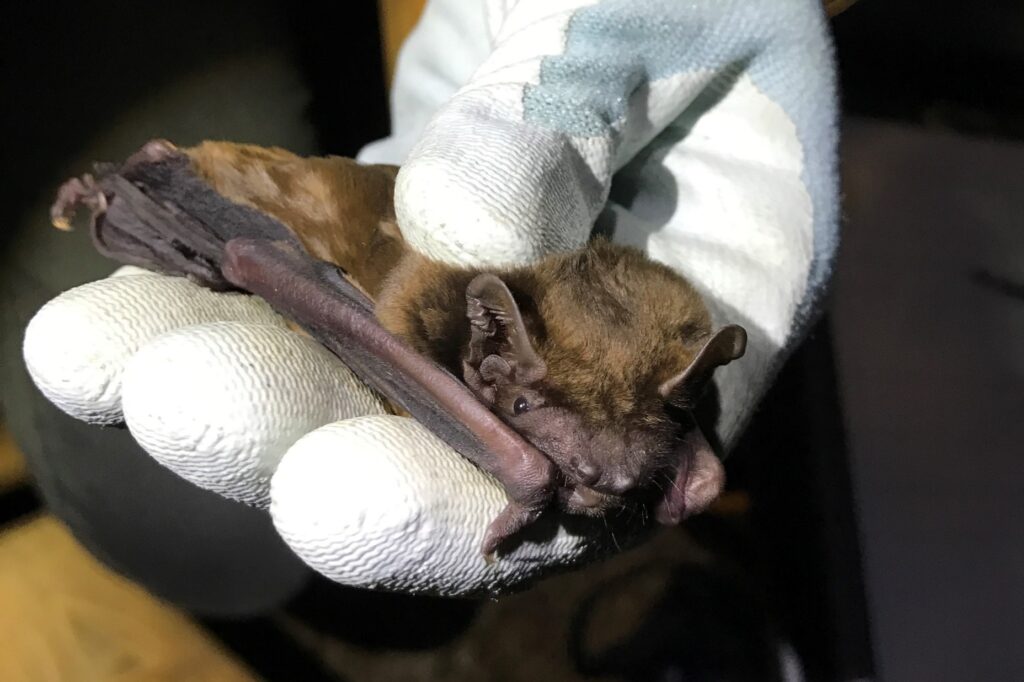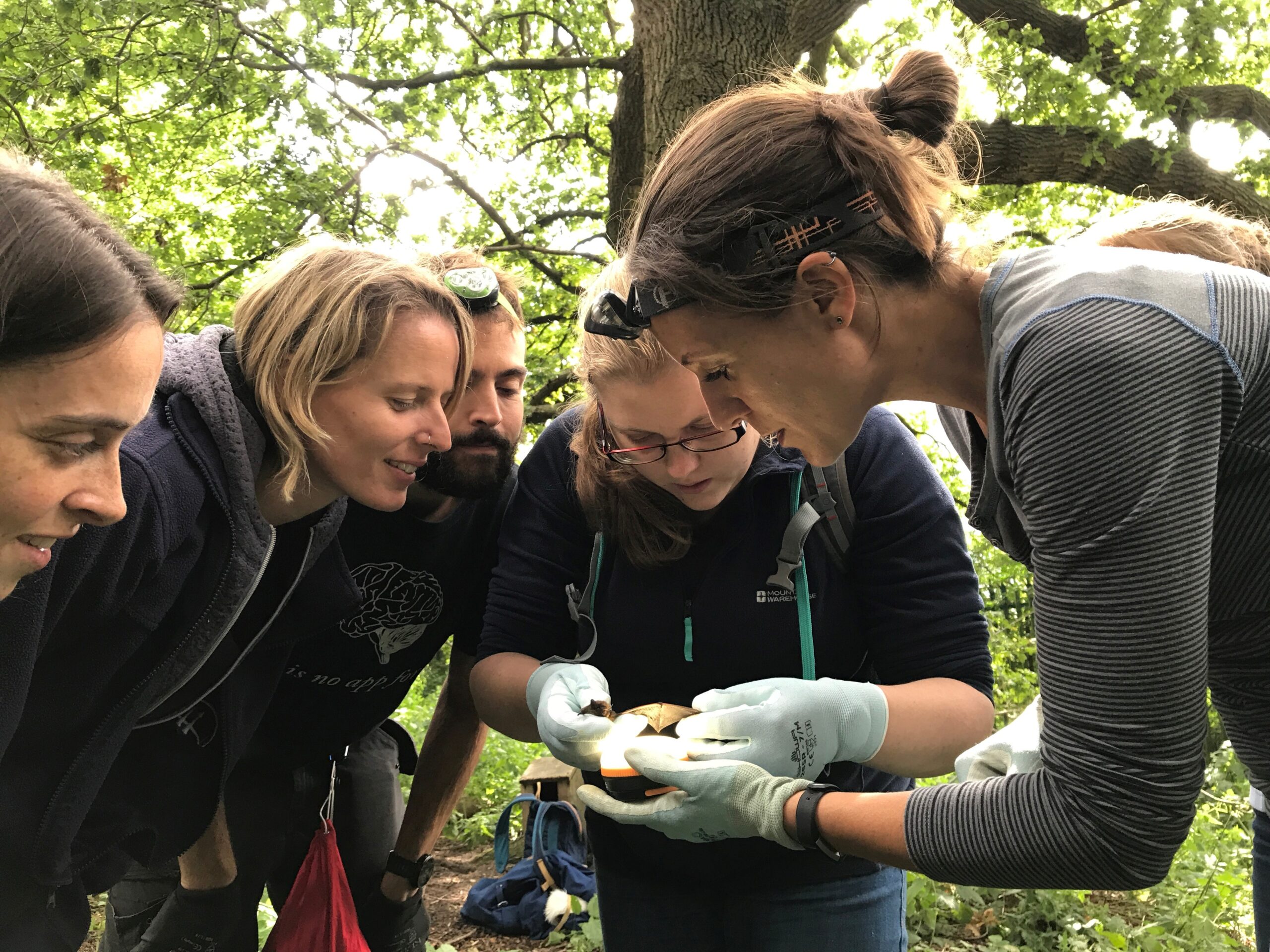Course title: Level 2 Bat Licence Training Course
Venue: Norwich, with field excursions around Norfolk
Duration: This intensive course takes place over three days, starting early afternoon on the first day with a late evening trapping session, full second day with a late evening trapping session and finishing at lunchtime on the third day.
Max no. attendees: 9
Cost: £885 per person
Course dates: Sold out, sorry! To join our mailing list and be notified if a place becomes available, please click here
Lead Tutor: Dr Charlotte (Lotty) Packman (other tutors will also be assisting)

About the course
The aim of this course is to provide participants with the knowledge and skills to utilise the Level 2 Bat Survey Class Licence (CL18) methods and practise their common applications. The Level 2 Course is designed to complement and strengthen your wider training and may be used to kick-start your training towards the Level 2 licence, as a ‘boost’ to your existing experience or to help you complete your training, filling in gaps and building skills and confidence.
The Level 2 licence permits the disturbance and surveying of bats using endoscopes, hand and static hand-held nets as well as artificial light (e.g. torches) and includes disturbance (but not handling) of hibernating bats.
More information on the Level 2 Class Licence can be found here.
Course session topics
- Bat handling and processing practice (daytime practical session with bats in care)
- Bat hand-netting, handling and processing (two late evening practical sessions)
- Bat species identification
- Using an endoscope (inc. practical session)
- Checking bat boxes (practical session)
- Using the Level 2 licence: ECoW, hibernation surveys and precautions
Common applications of the Level 2 licence
- Capture by hand or hand-net to confirm species/reproductive status
- Research and/or monitoring projects requiring collection of biometric data
- Building/tree visual inspections (using an endoscope to investigate potential roost features)
- Checking bat boxes (where likely to require bat handling)
- Ecological Clerk of Works (ECoW) under a Method Statement or European Protected Species (EPS) licence
- Hibernation surveys (not including handling)
- Collection of survey data contributing to EPS bat mitigation licence applications for development projects
NB: substantial experience and additional references are required to support those wishing to be the Named Ecologist on EPS licence applications, EPS licence applications are not covered by this course.
Level 2 course learning outcomes
- Use a hand-net to safely and competently capture bats
- Demonstrate correct methods for handling and processing bats
- Identify bat species in the hand
- Determine bat sex, age and reproductive status
- Take accurate biometric measurements (e.g. forearm and weight)
- Explain which actions can and cannot be carried out under the Level 2 Bat Survey Class Licence
- Apply the Level 2 licence survey methods to safely and effectively plan and carry out i) bat box checks; ii) investigation of potential roost features with an endoscope; iii) hibernation surveys
What is required for a Level 2 licence?
It is useful to know the competencies and experience you should be working towards gaining before applying for a Level 2 licence. Currently there are no standardised guidelines on experience criteria, so these are our recommendations only, based on our experience training many ecological consultants, researchers, students, bat group members and volunteers.
Bat handling and processing
We are often asked ‘how many bats should I have handled and processed before applying for my Level 2 licence?’ This is a difficult question to answer as there is considerable variation in how many bats people handle/process before they are ‘ready’ therefore there is no ‘magic number’. However, we appreciate that it is useful to have a rough indication of numbers needed, as a minimum.
For those wanting to apply for their Level 2 licence, we recommend that they have personally handled and processed (i.e. species identification, age, sex, female reproductive status, forearm and weight) a minimum of 40 bats in the last 5 years, to include at least the following species:
- common pipistrelle
- soprano pipistrelle
- brown long-eared bat
- one of the Myotis species
- one of the ‘big bat’ species
Before applying for your Level 2 licence, you must be able to safely, confidently and competently:
- Handle bats (including dorsal and ventral side up, passing between hands and ‘opening’ the wing on both sides)
- Identify the more common/more distinctive species in the hand, i.e. common pipistrelle, soprano pipistrelle, brown long-eared bat, noctule, serotine, Daubenton’s bat, Natterer’s bat, barbastelle, lesser horseshoe and greater horseshoe
- Competently use keys/ID guides for the rarer/trickier species, i.e. Nathusius’ pipistrelle, Leisler’s bat, the ‘WAB’ group and Bechstein’s bat
- Sex bats
- Age bats (i.e. adult/juvenile)
- Identify female reproductive status (e.g. pregnant, lactating, post-lactating etc.)
- Take accurate forearm measurements
- Take weight measurements
- Understand how to safely ‘store’ and release bats during trapping sessions.
- Have an awareness of bat health condition, signs of distress etc
Other Level 2 methods
You must also be able to safely, confidently and competently:
- Hand-net bats as they exit a roost and extract bats from hand-nets (we recommend a minimum of 10 bats hand-netted and extracted from hand-nets).
- Use an endoscope to investigate potential bat roost features (in buildings/trees).
- Survey potential hibernation sites for bats using a torch.
Licence reference (‘Course Completion Certificate’)
To meet the standard needed for a Level 2 licence, participants will need to have additional experience i.e. the course alone cannot provide all the experience you will need for your Level 2 licence. As described above, this course is intended to compliment your wider training, providing a ‘boost’ to your experience and skills or, potentially, to complete your training towards the licence.
Please note that provision of a ‘Course Completion Certificate’, which can be used in place of one reference for a licence application, is at the discretion of the course tutor and will only be provided if the tutor is fully satisfied that the participant has met the required standard, has passed the course assessments and following review of a satisfactory training log. Following the course, all attendees will be provided with a Continuing Professional Development (CPD) Certificate.
Pre-course recommendations & the course assessments
When you attend the Level 2 course it is assumed that you already hold a Level 1 Bat Survey Class Licence (CL17). We strongly recommend training and applying for your Level 1 licence before embarking on Level 2. The written and practical assessments may cover some broader knowledge areas, to ensure participants have the expected level of knowledge for the Level 1 licence, in addition to focussing on the Level 2 topics.
The basic level of knowledge we expect you to already have (and you may be tested on in the assessment) includes being able to:
- Describe the law relating to UK bats.
- Apply the Level 1 licence survey methods to safely and effectively plan and carry out; i) bat roost visual inspections of buildings (using artificial light); ii) visually identify common roosting bat species (without handling); iii) bat roost visual/ground assessments of trees; iv) bat emergence/re-entry surveys
The written and informal practical assessments will help to identify your competence level and highlight areas where you may need more practice/experience/knowledge.
After the course, we will provide you with a mark for your written assessment and feedback on both the theory and practical elements to help with your learning.
Rabies
You must be fully vaccinated against rabies (and up to date with any boosters needed). Please note, the vaccination process can take a considerable amount of time so this needs to be planned well in advance of attending the course if you are not currently vaccinated. You will need to confirm your rabies vaccination status prior to attending the course.
About the course Lead Tutor
Our Principal Bat Ecologist Dr Charlotte (Lotty) Packman specialises in bat consultancy, research and training. Based in Norwich, Lotty holds Level 3 and 4 Bat Survey Class Licences, is a Registered Consultant for the Bat Mitigation Class Licence and Bats in Churches Class Licence and also holds individual bat project/research licences. Having led research at the University of Bristol on the management of bats in churches, Lotty now supervises MSc research projects on bats in the UK and abroad and has extensive experience with bat trapping and radio-tracking.
Lotty was an Assessor for the Natural England Bat Earned Recognition pilot scheme and a member of the Technical Review Panel for the updating of BCT’s Bat Surveys for Professional Ecologists – Good Practice Guidelines (4th edition). Lotty is a Fellow of the Royal Society of Biology and a Chartered Biologist.




